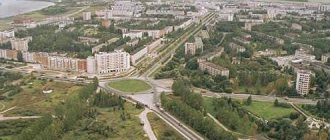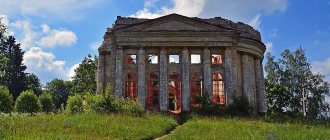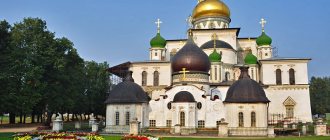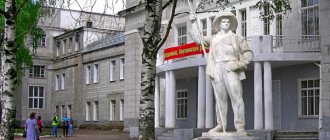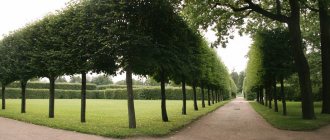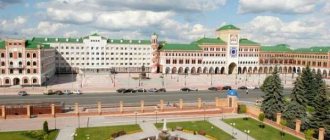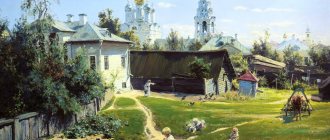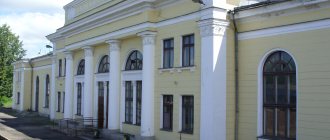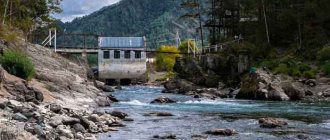Sights of Tosno and its surroundings
Historical information. The small town of Tosno is the administrative center of the Tosnensky district of the Leningrad region. Mentions of the lands at the mouth of the Tosna River can be found in historical documents of the 15th century. There is a possibility that Alexander Nevsky’s squad was located in these places before the battle at the mouth of the Neva.
In the 18th century, the border between Russia and Sweden passed along the Tosno River. As a result of the Northern War of 1700-1721, the Tosno lands were ceded to Russia.
Story
It was formed on August 19, 1930.
Then the Tosnensky district included 15 village councils, the village of Ulyanovka and the city of Lyuban. Subsequently, the territory of the district was repeatedly changed, village councils were added, and those already included were transformed. In 1996 it received the status of a municipal entity. In 2006 it was finally formed in its modern form.
Population and administrative structure
The population of the Tosnensky district is 129.6 thousand people. The maximum was recorded in 2015 – 131.8 thousand. However, since 2006 the area has added about 20 thousand population, so the dynamics are generally positive. This can be explained by the proximity to St. Petersburg; many people move here to live because real estate is cheaper here. According to official statistics, more than twenty thousand residents of the Tosnensky district work in St. Petersburg.
It is also worth noting the presence of gardening, due to which the population of the area increases significantly in the summer. The national composition is dominated by Russians.
Consists of five rural and eight urban settlements. They include 115 settlements, 15 have a population of more than 1,000 people, and 41 have a population of more than a hundred. This is quite a significant figure; in some areas of the Leningrad region, more than a hundred people live in 15-20 settlements.
Table. Rural settlements of the Tosnensky district.
| Name | Center | Population | Settlements included |
| Lisinskoe | Village Lisino-Korpus | 2060 | 17 |
| Nurminskoe | Village Nurma | 3300 | 3 |
| Telmanovskoe | Telman village | 14160 | 4 |
| Trubnikoborskoe | Trubnikov Bor village | 1630 | 16 |
| Shapkinskoe | Shapki village | 530 | 6 |
Table. Urban settlements of the Tosnensky district.
| Name | Center | Population | Settlements included |
| Krasnoborskoe | Urban settlement Krasny Bor | 5280 | 4 |
| Lyubanskoe | City of Lyuban | 9800 | 26 |
| Nikolskoye | Nikolskoye town | 22700 | 4 |
| Ryabovskoe | Urban settlement Ryabovo | 3320 | 1 |
| Tosnenskoye | City of Tosno | 43680 | 19 |
| Ulyanovskoe | Urban settlement Ulyanovka | 12650 | 1 |
| Fedorovskoe | Urban settlement Fedorovskoye | 3950 | 4 |
| Fornosovskoe | Urban settlement Fornosovo | 6600 | 10 |
Temples and churches in Tosno and the surrounding area
All guests of Tosno will be able to admire the beautiful church architecture - just go outside the city.
Church of the Smolensk Icon of the Mother of God
- Address: 1, village Manse.
Architectural monument of the mid-19th century. Russian-Byzantine style is located in the village of Manor, in the lands of the Novolisino estate. The church was built on the initiative of its owner Evgeniy Vonlyarlyarsky. Residents of the city of Smolensk, in gratitude for his intercession before the tsar, gave him an icon, which prompted the nobleman to build a temple.
The stone structure, the creation of the architect Boguslav Heidenreich, began to be erected in 1850. The project developed by the architect was personally approved by the monarch, Nikolai Pavlovich Romanov. The temple was consecrated in honor of the donated icon of Our Lady of Smolensk. The church was closed in 1935, but since 1990 it has been returned to believers and is still in operation today.
Church of the Kazan Icon of the Mother of God
- Address: ave. Lenina, 64.
There is a temple in Tosno, which in its modern appearance does not at all resemble a religious institution. Meanwhile, this is a historical landmark, because the church is about 300 years old.
The reason for the current unremarkable appearance of the temple lies in its complex history. During its existence, it was rebuilt several times. The fateful event was the restructuring of the 1950s, when the former temple was turned into a House of Culture.
The history of the Kazan Church began back in 1715. At first the temple was wooden, but after a fire in 1735 a stone one was built. In Soviet times, it worked, according to some sources, until 1943.
In 2009 there was a revival of religious life. The only reminder that this is a temple is a small onion dome with a cross placed above the entrance. Restoration of the facility is planned.
Church of the Kazan Icon of the Mother of God “Joy of All Who Sorrow”
- Address: ave. Lenina, 291A.
Kazan, or Skorbyashchenskaya, is the name given to the church located in the ancient city cemetery. Often there is confusion in sources with the object described above. The wooden, planked cemetery church is fully called “The Church of the Icon of the Mother of God, Joy of All Who Sorrow.”
It is notable for the uniqueness of its history; it appeared at a time when religious sites were closed all around. The opening date is considered to be 1936. Rebuilt from a wooden chapel from the mid-19th century. With minor interruptions, it continued its work throughout the Soviet era.
Trinity Church in Andrianovo
- Coordinates on the map: 59.418362, 30.899219.
The temple in the neo-Gothic style was built by architects I. Kolodin and P. Sadovnikov on the territory of the Maryino estate in 1831. The manor church became the family tomb of the Golitsyn family.
The cultural heritage site of Federal significance now does not function as a temple and lies in ruins. Some characteristic features of the architectural appearance have been preserved, for example, lancet windows. Even in a dilapidated state, the structure looks majestic.
Church of St. Nicholas the Wonderworker and Alexandra the Queen in the village. Ushaki
- Address: Ushaki village, Kirova Avenue.
An example of church architecture belonging to the pseudo-Russian style has been preserved in the village of Ushaki, now part of the urban settlement of Tosno. The red brick temple was built from 1902 to 1908 as a dedication to the crowned couple, in memory of the coronation of Nicholas II and his wife Alexandra. The temple was consecrated in honor of the patron saints of royalty. The church was closed in 1941 and began welcoming parishioners again in 1996.
Church of the Kazan Icon of the Mother of God in Ushaki
- Address: Parkovaya street, 2, Ushaki village.
In Ushaki there is an active church of the Kazan Icon of the Mother of God. A beautiful temple with azure domes decorated with stars is a remake from 2005 - 2009. Its construction was positioned as a restoration and tribute to the memory of a lost object.
Back in 1902, on the initiative of merchants and local landowners, a wooden church was built near the Ushaki railway station of the Nikolaev railway. In Soviet times it was closed, used as a club, and in 1984 there was a fire that completely destroyed the building.
Church-chapel of Tsarevich Alexei
- Address: Sablino station, Station Square.
In 1906, to commemorate the birth of the heir to the throne, Tsarevich Alexei, a wooden church, built in the traditions of Northern Russian architecture, was founded in the village of Sablino, in the Tosnensky district. The bombings of the Great Patriotic War destroyed the temple. In its place in the early 2000s, a massive single-domed chapel was built, which later received the status of a church.
The best on the site: Sights of St. Petersburg - TOP-60
Geography, relief and climate
The area of the Tosnensky district is 3585 square kilometers. It borders with the Novgorod region, St. Petersburg, as well as with the Luga, Gatchina, Kirishi and Kirov districts of the Leningrad region.
The relief of the Tosnensky district is predominantly flat, although in some places there are hills and elevated terrain. Most of the territory (80%) is covered with forest, and there are swamps. There are practically no lakes, the largest is Pendikovskoye. Of the large rivers, only Tosna is worth mentioning. In general, the Tosnensky district is not rich in water resources.
The climate is temperate continental, characterized by cool summers and mild winters. The average annual precipitation is 700 millimeters. The weather in general is no different from the Leningrad region as a whole. Air masses from the Atlantic Ocean have a great influence, thanks to which winters are often very warm, especially in recent years, when weather anomalies are regularly observed.
Official symbols
The heraldic emblem of the Municipal Formation Tosnensky District of the Leningrad Region was approved by the decision of the Meeting of Representatives of the Moscow Region dated October 28, 1998.
The coat of arms of the district is a silver horseshoe in a green field, the head, scarlet and gold, is burdened with three silver fir trees touching the lower edges of the crowns.
The horseshoe placed in the composition of the coat of arms indicates the history of the emergence of the city of Tosno as a postal station that arose in the 18th century. on the road from St. Petersburg to Moscow.
The spruce trees depicted in the coat of arms indicate the dense forests located in the area.
Economics and transport
The economic center of the Tosnensky district is the city of Tosno, and the overall economy is characterized by an emphasis on industry. The spheres of production of building materials, woodworking, extraction and processing of peat are developed. In agriculture, the emphasis is on vegetable growing (the district is a leader in the Leningrad region, growing more than 50% of vegetables).
More than 450 small enterprises and more than 1,700 individual entrepreneurs are registered in the Tosnensky district. Most of them are retail or service industries.
A railway line runs through the Tosnensky district, and the M-10 St. Petersburg - Moscow highway passes through the district. The ring road runs 15 kilometers from the northern border of the district.
Attractions
In the Tosnensky district there are attractions and interesting places that attract different tourists. Among the most significant, it is worth mentioning first of all the Sablinsky caves and waterfall. The caves are of artificial origin, about five kilometers long and are quite an interesting object.
Also worth mentioning in the list are the following attractions and interesting places in the Tosnensky district:
- Maryino Estate;
- Tosnensky Museum of Local Lore;
- Novolisino Estate;
- Art gallery in the city of Tosno.
These are places worth visiting. Please note that in transit you can only visit those attractions that are located in the city of Tosno (if you are traveling along the M-10). To visit the rest you need to set aside separate time.
Beautiful Tosno caves
The man-made Sablinsky caves, located on the territory of the natural monument of the same name, arose in the era of Catherine the Great, when sandy quartzite was mined in these places in order to develop the glass industry. Sometimes Sablinsky caves are called catacombs. In addition to Levoberezhnaya, tourists are also attracted to other caves. There are about 14 of them here. Below are some of the most interesting ones.
Pearl Cave
- Coordinates: 59.668799, 30.799739.
The length of the cave system, known as Zhemchuzhnaya, is about 5,500 meters. Inside the cave there is a labyrinth with two entrances, the height of the labyrinth corridors is about 160 meters. This cave is intended for independent visiting, but tourists are warned that some passages may be blocked or flooded.
In one of the cave halls there is an object called the “grave of the white speleologist.” Here is a set of rules of conduct. Some cave passages are very narrow. The multi-colored soil and sand layers on the cave walls look very picturesque.
Pants Cave
- Coordinates: 59.667430, 30.801293.
The cave system adjacent to Zhemchuzhnaya has a total length of 1.7 km. The “ceilings” here are low, from 1 to 1.6 meters, so you will have to crouch down to move around the cave. Of greatest interest is the narrow manhole, which was dubbed the “Trans-pipe” or “Leningrad tram”.
Rope Cave
- Coordinates: 59.661662, 30.802308.
A passage leading to the 800-meter-long cave, located on the right bank of the Tosno River, is located almost at water level. The Rope Cave is easy to navigate but atmospheric.
Count's Grotto
- Coordinates: 59.666492, 30.802588.
A small but simple and spacious 400-meter cave is known as Beach, Count or Count's Grotto. The height of the “ceilings” here reaches 5 meters.
Recreation and fishing
In the Tosnensky district there are interesting places that are visited by many tourists. This is largely facilitated by the proximity to St. Petersburg. Many places can be reached easily and quickly, even by public transport. However, it is worth noting that the tourist infrastructure in the area is poorly developed, so most come for one day.
There are also few campers with tents in the Tosnensky district; objectively speaking, there are no good places for this. This is largely due to the lack of bodies of water; as we wrote above, there are very few lakes here and most are very small. Therefore, from the point of view of fishing, the area is one of the worst in the Leningrad region. It’s definitely not worth going fishing to the Tosnensky district.
Tosnensky district is located in the south of the Leningrad region. In the north, the district borders with St. Petersburg, in the south - with the Novgorod region, in the northeast - with the Kirovsky district, in the west - with the Gatchina district, in the southwest - with the Luga district. There are 13 municipalities6, 7 urban and 6 rural settlements in the region. The district includes three cities - Tosno , Lyuban , Nikolskoye and more than 100 towns, villages and hamlets. The administrative center of the district is the city of Tosno .
Tosnensky district is one of the large districts of the Leningrad region. The area of the district is 3585.4 square meters. km. The population of the district in 2010 was 122,999 people.
The Tosno land was first mentioned in the Novgorod census salary book of 1500. Since the 18th century, the historical fate of the Tosno region was determined by its proximity to St. Petersburg. Since then, all trade routes from St. Petersburg to Moscow pass through Tosno, including the Rossiya highway and the Oktyabrskaya Railway.
In 1712, the settlement of Nikolskoye was founded on the right bank of the Tosna . Here, by decree of Peter I, Russians were resettled from Moscow and other provinces as artisans, who began developing rubble slabs, lime, brick, timber and alloying building materials along the Tosna to the Neva.
The first on the postal route when leaving St. Petersburg to Moscow through Srednyaya Rogatka and Sofia (Tsarskoe Selo) was the village of Yam-Izhora. Until 1869, the peasants living there, according to the right of coachmen, were not subject to the recruitment queue, did not pay taxes and received funds from the driver's duty. Later they were engaged in farming, producing matches, small trade and light transportation to railway stations.
Gradually, holiday villages with a rich history associated with the railway begin to develop near the railway. the names of outstanding writers, artists, poets, statesmen who once made the glory of Russia and lived here in their ancestral nests. These unique natural reserves and architectural monuments of the great masters of Russian architecture, and today occupy a special place in the Tosnensky district .
As an independent administrative unit with a center in the village of Tosno, the Tosnensky district was formed in 1930 by a resolution of the Presidium of the Leningrad Oblast Executive Committee, approved by the Presidium of the All-Russian Central Executive Committee.
On February 1, 1963, the city of Tosno was classified as a city of regional subordination.
Today, Tosnensky district is one of the leaders in the Leningrad region in terms of industrial production, vegetable yields, and construction of social facilities. Tosnensky district is the largest agricultural producer in the Leningrad region. The main industries are vegetable growing, dairy farming and pig farming.
The following roads pass through the area: M10 ( E 105 ) “Russia” (St. Petersburg - Moscow), P41 Luga - Pavlovo
The Tosno land is rich in cultural and historical monuments.
In 1967, a railway temple . The church was built at the request of the Chief Manager of Communications and Public Buildings P.P. Melnikov in memory of the builders of Russia's first double-track highway St. Petersburg-Moscow, the names of 72 of them are immortalized on a marble plaque inside the church. An unforgettable event in the parish of the church in 1894 was the 40-minute stop at the Lyuban station of the funeral train with the body of Emperor Alexander III , accompanied by Fr. John of Kronstadt.
The Maryino estate is a masterpiece of architectural architecture of the 18th–19th centuries. To this day, the palace building and an excellent landscape park have been preserved here.
Lisino-Korpus is a village that has been an imperial hunting ground since 1846. The estate complex, built according to the design of N. L. Benois, includes a hunting lodge, a church, a park, and the building of the first forestry technical school in Russia. The Lisinsky educational forestry, created in 1834, became the best forestry laboratory in Russia.
Temple of the Holy Martyr Tsarevich Alexy in the village. Ulyanovka
Existing Specially Protected Natural Areas
Glebovskoe swamp . Regional hydrological reserve. Gatchina, Luga and Tosnensky districts, between the settlements of Porozhek, Dubovik and Konechki.
Lisinsky . Regional complex reserve. Tosnensky district, vicinity of the village. Lisino-Korpus
Sablinsky . Complex natural monument. Tosnensky district, northern outskirts of the village. Ulyanovka
Projected and proposed protected areas, as well as other objects of nature-oriented tourism
Verigovschina . Regional zoological reserve. Tosnensky district, east of the village of Lyuban. Supposed to be organized for the purpose of protecting floodplain meadows along the river. Tigoda and rare species of birds: black stork, golden eagle, meadow and hen harrier, great snipe, gray crane.
Pomerania . Botanical natural monument. Tosnensky district, vicinity of the railway station. Pomerania. Intended to be organized for the purpose of protecting meadow areas with meadow plant species.
Fedorovskoe . Tosnensky district, river valley Izhora, near the village. Fedorovskoe
The deep canyons of the Sablinka and Tosny rivers , the uniquely beautiful Sablinsky caves, the largest waterfalls in the Leningrad region, beautiful deposits of limestone and sandstone, as well as the picturesque hills on which the ancient Russian village of Shapki is located have long become favorite places for tourists.
View a list of historical and cultural attractions in the area.
Museums in the area
1991 - On March 1, a decision was made by the Ministry of Culture of the Russian Federation to create the Tosno Museum of History and Local Lore . Tosno, Lenin Ave., 47-a
The museum was founded in 1993. The museum building was built in the 19th century. - the house of the royal nurse Ustinova-Smolina, later the revolutionary council was located here. Restored and opened on June 12, 2000. The history of the Tosnensky district is presented here (all interesting objects). Also presented is the corner of Numerov B.V. - Russian astronomer, founder of the Astronomical Institute. The opening of a crafts hall is planned.
10.00-18.00, days off: Monday, Sunday. Tel. 21-769, 25-956,
Sablinsky Museum of History and Local Lore , Tosnensky district, village. Ulyanovka, Volodarsky Ave., 70., Opened on the premises of Ulyanovsk School No. 1.
Museum of Nature and History of Russian Forestry , Tosnensky district, Lisino-Korpus village. Works at the Forestry College building. The Lisinsky forestry itself was created in 1834.
Museum of Military Glory , Tosnensky district, Nurma village. School Museum. The exhibition is dedicated to the feat of the Tosno division.
Hunters and fishermen's bases
Hunting farm "Fauna"
Tosnensky district, Ivanovskaya village, lake. Toilug
3-23-86
Hunting and fishing base "Pendikovo" Leningrad Society of Hunters and Fishers
Tosnensky district, lake Pendikovskoye, Nurma village
MOO Leningrad Society of Hunters and Fishers, St. Petersburg, emb. R. Buckles, 32.Only for hunters.
Official website of the district administration: www.tosno-online.com
